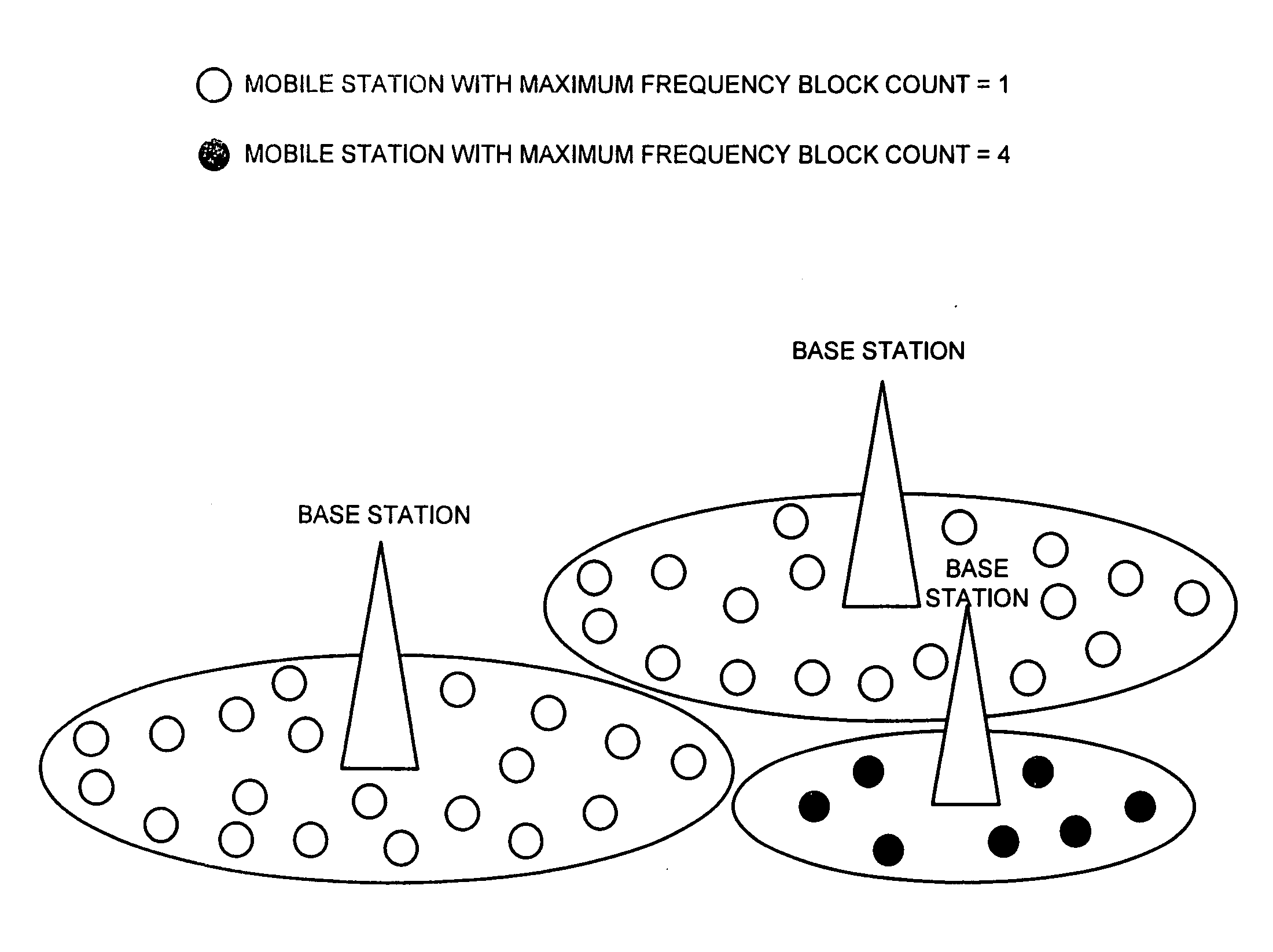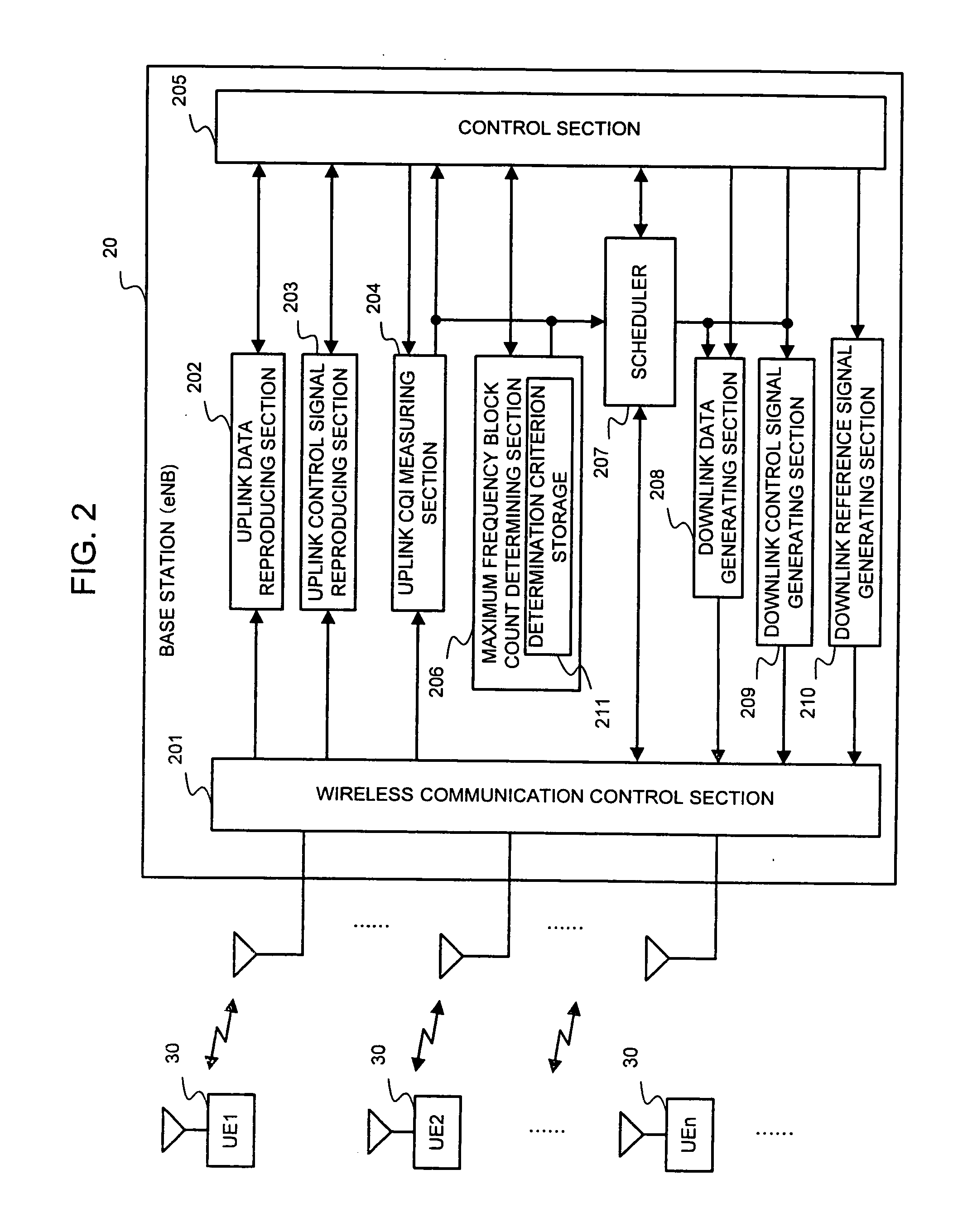Wireless communication system, wireless communication setting method, base station, mobile station, and program
a wireless communication and wireless communication technology, applied in wireless communication, wireless commuication services, transmission path division, etc., can solve the problems of greater overhead due to notification of information on resource block allocation, and placed limits on allocating consecutive resource blocks per mobile station within one, so as to enhance the multi-user diversity effect, improve system throughput, and increase overhead
- Summary
- Abstract
- Description
- Claims
- Application Information
AI Technical Summary
Benefits of technology
Problems solved by technology
Method used
Image
Examples
first embodiment
[0059]In a first embodiment, a configuration in which the maximum frequency block count is selected on a base station (cell)-by-base station basis will be described.
[0060]FIG. 1 is a diagram showing a case in which the maximum frequency block count is switched according to the size of a base station (cell).
[0061]In this case, since a sufficient margin of the transmit power may be allowed for a smaller cell size, the transmit bandwidth can be increased. In such a case, since a greater multi-diversity effect can be expected, the frequency block count is set to a larger value. On the other hand, since a base station (cell) with a larger cell size allows for an insufficient margin of the transmit power, the transmit bandwidth is reduced. In such a case, since a greater multi-diversity effect cannot be expected, the maximum frequency block count is decreased to reduce the overhead due to scheduling information.
[0062]FIG. 2 is a block diagram showing a main configuration of a base station...
second embodiment
[0092]While the maximum frequency block count is selected on a base station (cell)-by base station basis in the first embodiment, it is selected on a mobile station UE-by-mobile station basis in a second embodiment.
[0093]For example, a maximum frequency block count is determined according to a mobile station class (sometimes referred to as UE class) for each mobile station. The mobile station class refers to a class of the capability of a mobile station classified according to information on the communication capability of the mobile station, such as the transmit bandwidth, peak rate of transmission data, and number of transmit antennas, where a higher mobile station class corresponds to a mobile station capable of transmission at a higher speed. In particular, a mobile station of a low mobile station class has a smaller transmittable bandwidth. In this case, since the multi-user diversity effect, which is obtained by a multiplicity of discrete resource blocks (frequency blocks) all...
third embodiment
[0124]In the first and second embodiments, the maximum frequency block count is determined by a base station. According to a third embodiment described below, the maximum frequency block count is determined by a mobile station.
[0125]A system diagram in a mobile communications system to which the third embodiment is applied is similar to that of the second embodiment shown in FIG. 7, and therefore, explanation thereof will be omitted. Since the mobile station determines the maximum frequency block count in the third embodiment, the maximum frequency block count basically has a value specific to the mobile station.
[0126]FIGS. 12, 13 are block diagrams showing the main configurations of a base station and a mobile station in a mobile communications system to which the second embodiment is applied. Since in the third embodiment, the maximum frequency block count is determined by a mobile station, the maximum frequency block count determining section 206 and determination criterion stora...
PUM
 Login to View More
Login to View More Abstract
Description
Claims
Application Information
 Login to View More
Login to View More - R&D
- Intellectual Property
- Life Sciences
- Materials
- Tech Scout
- Unparalleled Data Quality
- Higher Quality Content
- 60% Fewer Hallucinations
Browse by: Latest US Patents, China's latest patents, Technical Efficacy Thesaurus, Application Domain, Technology Topic, Popular Technical Reports.
© 2025 PatSnap. All rights reserved.Legal|Privacy policy|Modern Slavery Act Transparency Statement|Sitemap|About US| Contact US: help@patsnap.com



